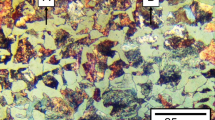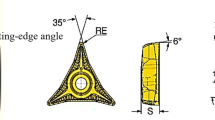Abstract
Nickel-aluminum bronze alloys are prone to tool surface bonding and wear on the tool substrate during the cutting process. The correlation between tool surface bonding morphology, rear face wear, and cutting force is analyzed in terms of the dry turning method for cutting 9442-nickel-aluminum bronze. The rational cutting parameters and the mechanism of tool wear are further discussed. The results indicate that adhesion, oxidation, and abrasive wear occur on the tool surface during turning. At a turning length of 2000 m, tool wear increases with increasing cutting speed and feed. There is a tool wear difference of 2 to 3 μm between adjacent cutting parameters, but the wear is similar at cutting speeds of 140 and 180 m/min. By appropriately reducing the cutting speed and feed rate, it is possible to promote the formation of an adhering layer on the rear face of the tool, thereby reducing overall tool wear. The best cutting results are achieved at a chip speed of 100 m/min and a feed rate of 0.05 mm/rev. However, at higher cutting speeds, there is susceptibility to the “bonding-flaking” phenomenon where material adheres to the tool surface, leading to fluctuations in cutting forces and accelerated tool wear. Higher feed rates result in increased cutting forces, which hinder the formation of an adhering layer on the rear face, causing severe wear on the tool matrix.

















Similar content being viewed by others
References
J. Carlton, Marine Propellers and Propulsion, Butterworth-Heinemann, Oxford, 2018.
P. Kuppahalli, R. Keshavamurthy, P. Sriram, and J.T. Kavya, Microstructural and Mechanical Behaviour of Nickel Aluminum Bronze Alloys, IOP Conf. Ser. Mater. Sci. Eng., 2019, 577(1), p 012044.
C. Shen, Z. Pan, D. Ding, L. Yuan, N. Nie, Y. Wang, D. Luo, D. Cuiuri, S. van Duin, and H. Li, The Influence of Post-production Heat Treatment on the Multi-directional Properties of Nickel-Aluminum Bronze Alloy Fabricated Using Wire-Arc Additive Manufacturing Process, Addit. Manuf., 2018, 23, p 411–421.
E.A. Culpan and G. Rose, Microstructural Characterization of Cast Nickel Aluminium Bronze, J. Mater. Sci., 1978, 13(8), p 1647–1657.
D.R. Ni, B.L. **ao, Z.Y. Ma, Y.X. Qiao, and Y.G. Zheng, Corrosion Properties of Friction–Stir Processed Cast NiAl Bronze, Corros. Sci., 2010, 52(5), p 1610–1617.
J. Anantapong, V. Uthaisangsuk, S. Suranuntchai, and A. Manonukul, Effect of Hot Working on Microstructure Evolution of As-cast Nickel Aluminum Bronze Alloy, Mater. Des., 2014, 60, p 233–243.
I.N. Tansel, T.T. Arkan, W.Y. Bao, N. Mahendrakar, B. Shisler, D. Smith, and M. McCool, Tool Wear Estimation in Micro-Machining.: Part I: Tool Usage–Cutting Force Relationship, Int. J. Mach. Tools Manuf, 2000, 40(4), p 599–608.
S.E. Oraby and D.R. Hayhurst, Development of Models for Tool Wear Force Relationships in Metal Cutting, Int. J. Mech. Sci., 1991, 33(2), p 125–138.
K.M. Li and S.Y. Liang, Modeling of Cutting Forces in Near Dry Machining under Tool Wear Effect, Int. J. Mach. Tools Manuf, 2007, 47(7–8), p 1292–1301.
X. Chuangwen, D. Jianming, C. Yuzhen, L. Huaiyuan, S. Zhicheng, and X. **g, The Relationships Between Cutting Parameters, Tool Wear, Cutting Force and Vibration, Adv. Mech. Eng., 2018, 10(1), p 1–14.
Y. Ding, J. Yu, and Z. Lu, The Relationship Between Adhesion Morphology and Cutting Force in Orthogonal Cutting of 6061-T6 Aluminum Alloy, Int. J. Adv. Manuf. Technol., 2022, 124(5–6), p 1971–1991.
A. Sarhan, R. Sayed, A.A. Nassr, and R.M. El-Zahry, Interrelationships Between Cutting Force Variation and Tool Wear in End-Milling, J. Mater. Process. Technol., 2001, 109(3), p 229–235.
Y. Gao, G. Wang, M.J. Bermingham, and M.S. Dargusch, Cutting Force, Chip Formation, and Tool Wear during the Laser-Assisted Machining a Near-Alpha Titanium Alloy BTi-6431S, Int. J. Adv. Manuf. Technol., 2015, 79(9–12), p 1949–1960.
Y. Feng, T. Hung, Y. Lu, Y. Lin, F. Hsu, C. Lin, Y. Lu, and S.Y. Liang, Flank Tool Wear Prediction of Laser-Assisted Milling, J. Manuf. Process., 2019, 43, p 292–299.
D.H. **ang, G.X. Yue, X.T. Zhi, G.F. Gao, and B. Zhao, Study on Cutting Force and Tool Wear of High Volume SiC/Al MMCs with Ultrasonic Vibration High Speed Milling, Key Eng. Mater., 2010, 455, p 264–268.
Y. Feng, F.C. Hsu, Y.T. Lu, Y.F. Lin, C.T. Lin, C.F. Lin, Y.C. Lu, and S.Y. Liang, Tool Wear Rate Prediction in Ultrasonic Vibration-Assisted Milling, Mach. Sci. Technol., 2020, 24(5), p 758–780.
C. Ni, L. Zhu, and Z. Yang, Comparative Investigation of Tool Wear Mechanism and Corresponding Machined Surface Characterization in Feed-Direction Ultrasonic Vibration Assisted Milling of Ti-6Al-4V from Dynamic View, Wear, 2019, 436, 203006.
Y. Sun, H. Wang, W. Liu, G. Song, and Q. Li, Improvement of Surface Resistance to Cavitation Corrosion of Nickel Aluminum Bronze by Electropulsing-Assisted Ultrasonic Surface Rolling Process, Surf. Coat. Technol., 2019, 368, p 215–223.
Y. Gao, W. Yang, Z. Huang, and Z. Lu, Effects of Residual Stress and Surface Roughness on the Fatigue Life of Nickel Aluminium Bronze Alloy Under Laser Shock Peening, Eng. Fract. Mech., 2021, 244, 107524.
Z. Wu, Y.F. Cheng, L. Liu, W. Lv, and W. Hu, Effect of Heat Treatment on Microstructure Evolution and Erosion–Corrosion Behavior of a Nickel-Aluminum Bronze Alloy in Chloride Solution, Corros. Sci., 2015, 98, p 260–270.
Z. Li, H. Yan, P. Zhang, J. Guo, Z. Yu, and J.W. Ringsberg, Improving Surface Resistance to Wear and Corrosion of Nickel-Aluminum Bronze by Laser-Clad TaC/Co-Based Alloy Composite Coatings, Surf. Coat. Technol., 2021, 405, 126592.
K. Maneesh, M. Shan, S. Xavier, M.B. Vinayak, and M. Shafeek, Quality Characteristic Optimization in CNC Turning of Aluminum Bronze by Using Taguchi’s Approach and ANOVA, Mater. Today Proc., 2023, 80, p 620–628.
Y. Li, D. Zhang, T.L. Ngai, W. **a, and Y. Long, Diffusion Couple Between High-Strength Wear-Resisting Aluminum Bronze and Machining Tools Materials, Trans. Nonferrous Met. Soc. China, 1999, 9(1), p 6–10.
Y. Li, T.L. Ngai, W. **a, Y. Long, and D. Zhang, A Study of Aluminum Bronze Adhesion on Tools during Turning, J. Mater. Process. Technol., 2003, 138(1–3), p 479–483.
T.L. Ngai, W. **a, D. Zhang, G. Guo, and M. Shao, Tool Wear Mechanism in Turning of Novel Wear-Resisting Aluminum Bronze, Trans. Nonferrous Met. Soc. China, 2003, 13(1), p 165–169.
S. Qu, F. Sun, L. Zhang, and X. Li, Effects of Cutting Parameters on Dry Cutting of Aluminum Bronze Alloy, Int. J. Adv. Manuf. Technol., 2013, 70(1–4), p 669–678.
Z. Fu, W. Yang, S. Zeng, B. Guo, and S. Hu, Identification of Constitutive Model Parameters for Nickel Aluminum Bronze in Machining, Trans. Nonferrous Met. Soc. China, 2016, 26(4), p 1105–1111.
R. Furushima, K. Shimojima, H. Hosokawa, and A. Matsumoto, Oxidation-Enhanced Wear Behavior of WC-FeAl Cutting Tools Used in Dry Machining Oxygen-Free Copper Bars, Wear, 2017, 374–375, p 104–112.
S.A. Bagaber and A.R. Yusoff, Multi-Objective Optimization of Cutting Parameters to Minimize Power Consumption in Dry Turning of Stainless Steel 316, J. Clean. Prod., 2017, 157, p 30–46.
A.E. Diniz and R. Micaroni, Influence of the Direction and Flow Rate of the Cutting Fluid on Tool Life in Turning Process of AISI 1045 Steel, Int. J. Mach. Tools Manuf, 2007, 47(2), p 247–254.
G.J. Hunt, M.P. Gahagan, and M.A. Peplow, Wire Resistance Method for Measuring the Corrosion of Copper by Lubricating Fluids, Lubr. Sci., 2017, 29(4), p 279–290.
X. Meng, Y. Lin, and S. Mi, The Research of Tool Wear Mechanism for High-Speed Milling ADC12 Aluminum Alloy Considering the Cutting Force Effect, Materials, 2021, 14(5), p 1054.
X. Liang, Z. Liu, and B. Wang, Multi-Pattern Failure Modes and Wear Mechanisms of WC-Co Tools in Dry Turning Ti-6Al-4V, Ceram. Int., 2020, 46(15), p 24512–24525.
Y.H. Fan, Z.P. Hao, J.Q. Lin, and Z.X. Yu, Material Response at Tool–Chip Interface and its Effects on Tool Wear in Turning Inconel718, Mater. Manuf. Process., 2014, 29(11–12), p 1446–1452.
H.B. He, H.Y. Li, X.Y. Zhang, Q.B. Yue, J. Zhang, L. Ma, and Y.M. Li, Research on the Cutting Performances and Wear Mechanisms of TiAlCrN Coated Tools during dry Turning, Int. J. Precis. Eng. Manuf., 2019, 20, p 201–207.
Q. Xu, J. Zhao, and X. Ai, Cutting Performance of Tools Made of Different Materials in the Machining of 42CrMo4 High-Strength Steel: A Comparative Study, Int. J. Adv. Manuf. Technol., 2017, 93, p 2061–2069.
S. Zhang, J.F. Li, J. Sun, and F. Jiang, Tool Wear and Cutting Forces Variation in High-Speed End-Milling Ti-6Al-4V Alloy, Int. J. Adv. Manuf. Technol., 2009, 46(1–4), p 69–78.
S. Zhang, J.F. Li, J. Sun, and F. Jiang, Tool Wear and Cutting Forces Variation in High-Speed End-Milling Ti-6Al-4V Alloy, Int. J. Adv. Manuf. Technol., 2010, 46, p 69–78.
S. Debnath, M.M. Reddy, and Q.S. Yi, Influence of Cutting Fluid Conditions and Cutting Parameters on Surface Roughness and Tool Wear in Turning Process Using Taguchi Method, Measurement, 2016, 78, p 111–119.
A. Saligheh, A. Hajialimohammadi, and V. Abedini, Cutting Forces and Tool Wear Investigation for Face Milling of Bimetallic Composite Parts Made of Aluminum and Cast Iron Alloys, Int. J. Eng. Sci., 2020, 33(6), p 1142–1148.
J. Zuo, Y. Lin, P. Zhong, and Y. Liu, Investigation on Adhesive Wear Process of Tool Coating Surface under High-Adhesive Rate Environment in Cutting Beryllium-Copper C17200 Alloy, Mater. Lett., 2020, 279, 128488.
I. Svenningsson and K. Tatar, On the Mechanism of Three-Body Adhesive Wear in Turning, Int. J. Adv. Manuf. Technol., 2021, 113(11–12), p 3457–3472.
Y.H. Fan, Z.P. Hao, M.L. Zheng, and S.C. Yang, Wear Characteristics of Cemented Carbide Tool in Dry-Machining Ti-6Al-4V, Mach. Sci. Technol.. Sci. Technol., 2016, 20(2), p 249–261.
F. Wang, K. Ji, and Z. Guo, Microstructural Analysis of Failure Progression for Coated Carbide Tools during High-Speed Milling of Ti-6Al-4V, Wear, 2020, 456–457, 203356.
J.L. Cantero, J. Díaz-Álvarez, M.H. Miguélez, and N.C. Marín, Analysis of Tool Wear Patterns in Finishing Turning of Inconel 718, Wear, 2013, 297(1–2), p 885–894.
Acknowledgments
The authors sincerely appreciate the financial support from the National Natural Science Foundation of China (Grant No. 52205185 and Grant No. 51975123). Support from the Project on the Integration of Industry, Education and Research of Fujian Province, China (Grant No. 2021Y4004) is highly acknowledged.
Author information
Authors and Affiliations
Corresponding author
Ethics declarations
Conflict of interest
The authors declared that there is no conflict of interest.
Additional information
Publisher's Note
Springer Nature remains neutral with regard to jurisdictional claims in published maps and institutional affiliations.
Rights and permissions
Springer Nature or its licensor (e.g. a society or other partner) holds exclusive rights to this article under a publishing agreement with the author(s) or other rightsholder(s); author self-archiving of the accepted manuscript version of this article is solely governed by the terms of such publishing agreement and applicable law.
About this article
Cite this article
Zou, W., Lai, F., Yi, D. et al. Variation of Cutting Forces with Different Cutting Parameters and Tool Wear during Turning of 9442-Nickel-Aluminum Bronze. J. of Materi Eng and Perform (2024). https://doi.org/10.1007/s11665-024-09609-x
Received:
Revised:
Accepted:
Published:
DOI: https://doi.org/10.1007/s11665-024-09609-x




